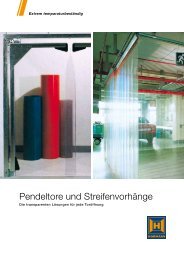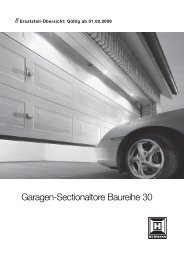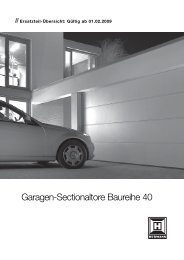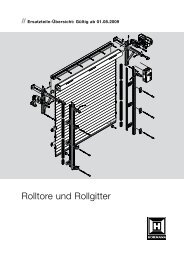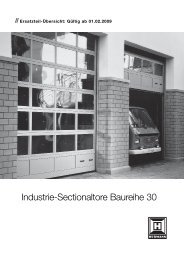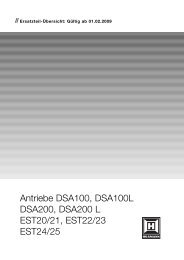You also want an ePaper? Increase the reach of your titles
YUMPU automatically turns print PDFs into web optimized ePapers that Google loves.
ENGLISH<br />
2 INSTALLATION INSTRUCTIONS<br />
Note<br />
When drilling holes, cover the operator so as to avoid the<br />
penetration of dust and shavings, since these can lead to<br />
malfunctions.<br />
2.1 Garage door operator<br />
2.2 Required clearance for installing the operator<br />
When installing the operator the clearance between the<br />
door at its highest point of travel and the ceiling must be<br />
at least 30 mm (see fig. 1.1a/1.1b). Please check<br />
these dimensions!<br />
2.3 On a sectional door, the mechanical latch must be<br />
completely dismantled (see fig. 1.3a).<br />
ATTENTION<br />
When installing the operator the pull rope must<br />
be removed (see fig. 1.2a)<br />
2.4 Centrally positioned lock on a sectional door<br />
For sectional doors with a centrally positioned handle,<br />
fit the lintel bracket and the door link bracket off-centre<br />
(see fig. 1.5a).<br />
2.5 Off-centred reinforcement profile on a sectional<br />
door<br />
In the case of an off-centred reinforcement profile on a<br />
sectional door, fit the door link bracket to the nearest<br />
reinforcement profile on the left or right (see fig. 1.5a).<br />
Note<br />
For timber doors, use - contrary to the illustrated section -<br />
5 x 35 wood screws from the pack of screws supplied with<br />
the door (3 mm Ø drill hole).<br />
2.6 The mechanical latches on an up-and-over door<br />
must be immobilized (see figs. 1.2b/1.3b/1.4b ). The<br />
latches for door models not referred to in these<br />
instructions must be locked in position on site.<br />
2.7 Note<br />
For up-and-over doors with an ornamental wrought<br />
iron door handle - contrary to the illustrated section<br />
(see figs. 1.5b/1.6b) - the lintel bracket and the door link<br />
bracket must be attached off-centre.<br />
For N80-doors with timber infill, the lower holes in the lintel<br />
bracket have to be used for installation (see fig. 1.6b).<br />
2.8 Boom<br />
ATTENTION<br />
Depending on the application, only the booms<br />
recommended by us may be used for the garage<br />
door operators (see product information).<br />
2.9 Before installing the boom<br />
Note<br />
Before mounting the boom to the lintel or ceiling, push the<br />
carriage in the engaged state (see section 2.11.2) approx.<br />
20 cm from the CLOSE end-of-travel position into the OPEN<br />
end-of-travel position. It is no longer possible to do this with<br />
the carriage engaged, once the limit stops and the operator<br />
have been installed (see fig. 2.1).<br />
2.10 Installing the boom<br />
Note<br />
For underground and collective garage operators, the boom<br />
has to be fixed to the ceiling using a second support. See<br />
figs. 2.4a and 2.5 for mounting.<br />
2.11 Boom operating modes<br />
The boom allows two different operating modes:<br />
2.11.1 Manual operation (see fig. 4.1)<br />
The carriage is disengaged from the belt lock; i.e. the<br />
door is not directly connected to the operator enabling<br />
the door to be moved by hand.<br />
To disengage the carriage, the rope of the mechanical<br />
release must have been pulled.<br />
Note<br />
If on disengagement the carriage is at the CLOSE end-oftravel<br />
position, the rope of the mechanical release must be<br />
pulled until the carriage has been moved so far along the<br />
boom that it can no longer hook into the limit stop (carriage<br />
travels a distance of approx. 3 cm). To be able to permanently<br />
operate the door manually, the rope must be fixed<br />
on the carriage as shown in fig. 4.2.<br />
ATTENTION<br />
If in countries in which the European Standard<br />
EN 13241-1 must be complied with, the garage<br />
door operator is retrofitted by a specialist to a<br />
<strong>Hörmann</strong> sectional door without spring<br />
breakage safety device (BR30), the installer<br />
responsible must also install a retrofit kit to the<br />
carriage. This kit comprises a screw to secure<br />
the carriage against inadvertent disengagement<br />
and a new pull rope sign, showing how to use<br />
the kit and carriage in the two boom operating<br />
modes.<br />
2.11.2 Automatic operation (see fig. 6)<br />
The belt lock is engaged in the carriage, i.e. the door<br />
and the operator are connected to each other, thereby<br />
allowing power operation of the door.<br />
To prepare the carriage for engagement, the green button<br />
must be pressed. The belt must then be moved towards<br />
the carriage until the belt lock engages into it.<br />
ATTENTION<br />
Do not insert fingers into the boom while the<br />
door is moving ➜ Risk of trapped fingers!<br />
2.12 Establishing the end-of-travel positions by<br />
installing the limit stops<br />
1) Insert the limit stop for the OPEN end-of-travel position<br />
loosely into the boom between the carriage and the<br />
drive unit. Push the door by hand into the OPEN<br />
position. In doing so, the limit stop is pushed into the<br />
correct position. Secure the limit stop for the OPEN<br />
end-of-travel position (see fig. 5.1).<br />
Note<br />
If in the OPEN end-of-travel position the door does not<br />
reach the full passage height, the limit stop can be removed<br />
so that the integrated limit stop (in the drive unit head) is<br />
used.<br />
54 05.2007 TR10A042-B RE<br />
➤



